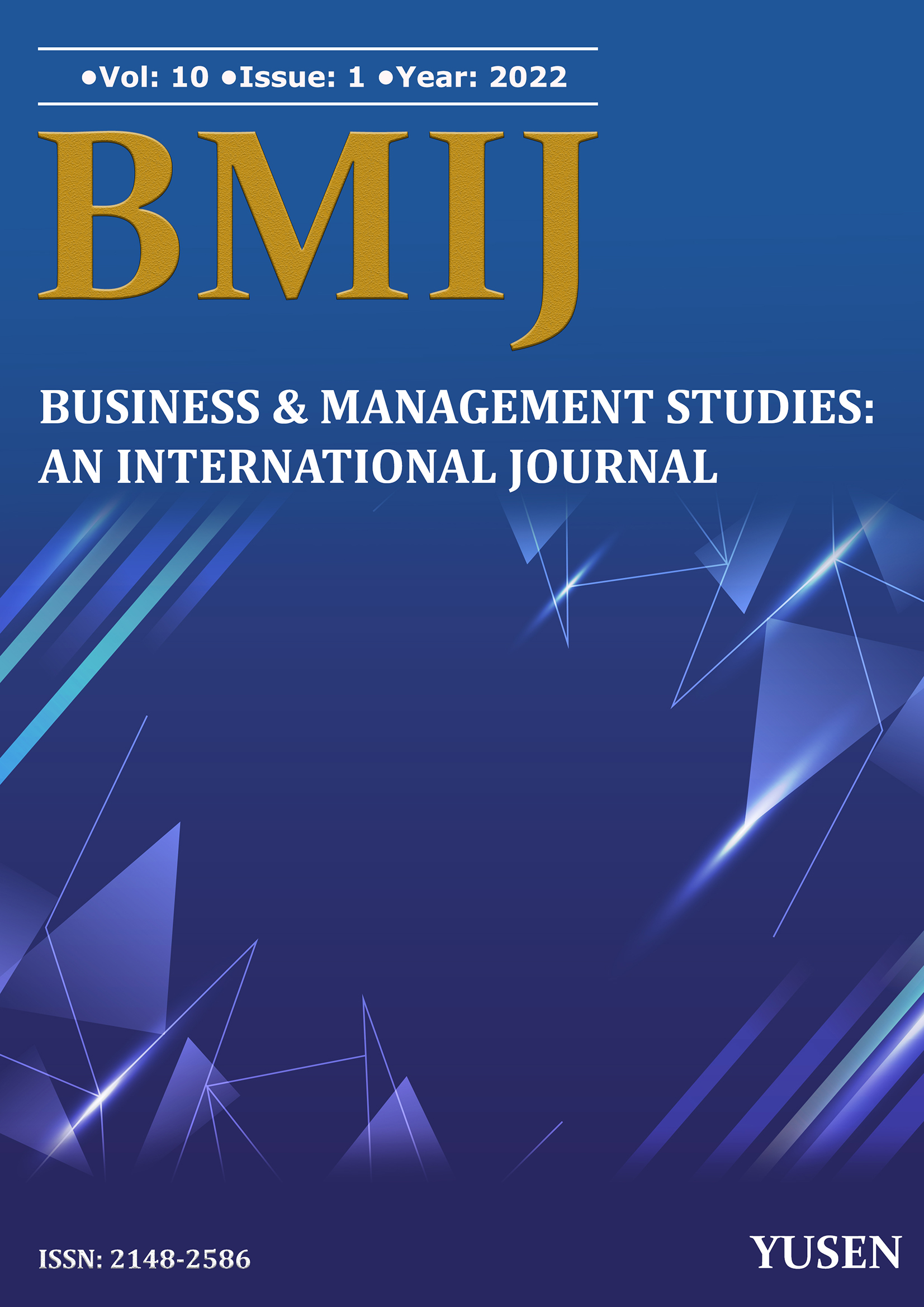
Yayınlanmış 26.03.2022
Anahtar Kelimeler
- Teknoloji, Duygusal Zekâ, Nomofobi
- Technology, Emotional Intelligence, Nomophobia
Nasıl Atıf Yapılır
Telif Hakkı (c) 2022 Rukiye Can Yalçın- Pınar Fayganoğlu- Memduh Begenirbaş

Bu çalışma Creative Commons Attribution-NonCommercial-NoDerivatives 4.0 International License ile lisanslanmıştır.
Nasıl Atıf Yapılır
Öz
Nomofobi, modern zaman bağımlılığı olarak ifade edilebilmektedir. Kavramın en önemli psikolojik etkenleri, cinsiyet ve sosyoekonomik durumun yanı sıra kişilik, duygusal zekâ, sosyal beceriler, uyum yetenekleri, benlik saygısı, sigara, alkol ve uyuşturucu tüketimi, eşlik eden diğer psikopatolojilerdir (Bragazzi ve Del Puente, 2014). Düşük duygusal zekâya sahip bireylerin bağımlılık türlerine yatkınlığını ortaya koyan çalışmalardan hareketle, yine farklı bir bağımlılık türüne atıfta bulunan nomofobi yaşama olasılıklarının da yüksek olduğu değerlendirilmektedir. Söz konusu noktadan hareketle, bu çalışma, üniversite öğrencilerinde duygusal zekâ ve nomofobi düzeyi arasındaki ilişkiyi incelemek üzere gerçekleştirilmiştir. Bu doğrultuda, Ankara’da bulunan üniversitelerde eğitim gören 258 öğrenciden anket yoluyla elde edilen veriler analiz edilmiştir. Çalışmada her bir değişkene ait doğrulayıcı faktör analizi (DFA) AMOS programı ile yapılmıştır. Değişkenler arası ilişkileri ortaya koymak için korelasyon analizi, hipotezlerin test edilmesi maksadıyla hiyerarşik regresyon analizi yapılmıştır. Bulgulara göre, üniversite öğrencilerinin duygusal zekâ düzeyi nomofobi üzerinde önemli etkilere sahiptir. Bu bağlamda, duygusal zekanın nomofobi ile negatif ilişkili olduğu sonucuna varılmıştır. Elde edilen bulgular ışığında, üniversite öğrencileri ve eğitim sektörü yöneticilerine de konu ile ilgili önerilerde bulunulmuştur.
Referanslar
- Afacan Fındıklı, M., Okan, G. ve Sığrı, Ü. (2019). Karanlık Liderlik Ölçeği: Çalışanların Algısı Üzerine Bir Ölçeklendirme Çalışması. Nitel Sosyal Bilimler, 1(1), 89-115.
- Alexander, J. A. M., Van Deursen, A. J. A. M., Bolle, C. L., Hegner, S. M., ve Kommers, P. A. M. (2015). Modeling habitual and addictive smartphone behavior. The role of smartphone usage types, emotional intelligence, social stress, self-regulation, age, and gender. Computers in Human Behavior, 45, 411–420. https://doi.org/10.1016/j.chb.2014.12.039.
- Baron, R.M. ve Kenny, D.A. (1986). The Moderator Mediator Variable Distinction in Social Psychological Research: Conceptual, Strategic, and Statistical Considerations. Journal of Personality and Social Psychology, 51, 1173-1182.
- Bar-On, R. (1997). Bar-On Emotional Quotient Inventory: User's manual. Toronto: MultiHealth Systems.
- Beranuy, M., Oberst, U., Carbonell, X., ve Chamarro, A. (2009). Problematic Internet and mobile phone use and clinical symptoms in college students: The role of emotional intelligence. Computers in human behavior, 25(5), 1182-1187.
- Black, D. W., Belsare, G., ve Schlosser, S. (1999). Clinical features, psychiatric comorbidity, and health-related quality of life in persons reporting compulsive computer use behavior. Journal of Clinical Psychiatry, 60, 839–844.
- Bragazzi, N. L., ve Del Puente, G. (2014). A Proposal for Including Nomophobia in The New DSM-V. Psychology Research and Behavior Management, 7, 155-160.
- Büyüköztürk, Ş., Çakmak, E. K., Akgün, Ö. E., Karadeniz, Ş. ve Demirel, F. (2008), Bilimsel Araştırma Yöntemleri (Geliştirilmiş 2. baskı), Ankara, Pegem Akademi ve Yayıncılık.
- Büyüköztürk, Ş. (2007). Sosyal Bilimler İçin Veri Analizi El Kitabı, Ankara, Pegem Akademi ve Yayıncılık.
- Charbonneau, D., ve Nicol, A. A. M. (2002). Emotional intelligence and leadership in adolescents. Personality and Individual Differences, 33, 1101–1113.
- Cheever, N. A., Rosen, L. D., Carrier, L. M., & Chavez, A. (2014). Out of sight is not out of mind: The impact of restricting wireless mobile device use on anxiety levels among low, moderate and high users. Computers in Human Behavior, 37, 290–297.
- Chóliz, M. (2012). Mobile-phone addiction in adolescence: The test of mobile phone dependence (TMD). Progress in Health Sciences, 2(1), 33–44.
- Cooper, R.K. ve Sawaf, A.(2003), Liderlikte Duygusal Zekâ, (Çev. Zelal Bedriye Ayman-Banu Sancar), Sistem Yayıncılık, Üçüncü Basım, İstanbul.
- Cumming, E. A. (2005). An investigation into the relationship between emotional intelligence and workplace performance: An exploratory study, Presented Paper. Lincoln University.
- Davie, N. ve Hilber, T. (2017). Nomophobia: Is smartphone addiction a genuine risk for Mobile learning? International Association for Development of the Information Society.
- Deniz, M. E., Özer, E., ve Işık, E. (2013). Duygusal zekâ özelliği ölçeği–kısa formu: geçerlik ve güvenirlik çalışması. Eğitim ve Bilim, 38(169).
- Engelberg, E., ve Sjöberg, L. (2004). Internet use, socialskills and adjustment. Cyberpsychology & Behavior, 7(1), 41–47.
- Erdem, H., Kalkın, G., Türen, U., ve Deniz, M. (2016). Üniversite Öğrencilerinde Mobil Telefon Yoksunluğu Korkusunun (Nomofobi) Akademik Başarıya Etkisi. Süleyman Demirel Üniversitesi İktisadi ve İdari Bilimler Fakültesi Dergisi, 21(3), 923-936.
- Feist, G. J., ve Barron, F. (1996, June). Emotional intelligence and academic intelligence in career and life success. Paper presented at the Annual Convention of the American Psychological Society, San Francisco, CA.
- Gardner, H. (1983). Frames of mind: the theory of multiple intelligences. New York: Basic Books.
- Gentina, E., Tang, T. L. P., ve Dancoine, P. F. (2018). Does Gen Z's emotional intelligence promote iCheating (cheating with iPhone) yet curb i Cheating through reduced nomophobia? Computers & Education, 126, 231-247.
- Gibbs, N. (1995). (October 2). The EQ factor. Time, 60–68.
- Goleman, D. (1995). Emotional intelligence: why it can matter more than IQ. London: Bloomsbury.
- Goleman, D. (2000), İşbaşında Duygusal Zekâ, (Çev. Handan Balkara), Varlık Yayınları Sayı:580 Üçüncü Basım, İstanbul.
- Greenspan, S. I. (1989). Emotional intelligence. In K. Field, B. J. Cohler, & G. Wool (Eds.), Learning and education: psychoanalytic perspectives (pp. 209–243). Madison, CT: International Universities Press.
- Hoeven, C. L. T., Van Zoonen, W., ve Fonner, K. L. (2016). The Practical Paradox of Technology: The Influence of Communication Technology Use on Employee Burnout and Engagement. Communication Monographs, 83(2), 239-263.
- Hong, F.-Y., Chiu, S.-I., & Huang, D.-H. (2012). A model of the relationship between psychological characteristics, mobile phone addiction and use of mobile phones by Taiwanese university female students. Computers in Human Behavior, 28(6), 2152–2159.
- Isaacs, D. (2016). Work-life balance. Journal of Pediatrics and Child Health, 52(1), 5–6.
- Jena, R. K. (2015). Compulsive use of smartphone and its effect on engaged learning and nomophobia. SMART Journal of Business Management Studies, 11(1), 42–51.
- Jenaro, C., Flores, N., Gomez-Vela, M., Gonzalez-Gil, F., & Caballo, C. (2007). Problematic internet and cellphone use: Psychological, behavioral, and health correlates. Addiction Research & Theory, 15(3), 309– 320.
- Kara, M., Baytemir, K., ve Inceman-Kara, F. (2021). Duration of daily smartphone usage as an antecedent of nomophobia: Exploring multiple mediation of loneliness and anxiety. Behaviour & Information Technology, 40(1), 85-98.
- King, A. L S., Valença, A. M., ve Nardi, A. E. (2010). Nomophobia: The Mobile Phone in Panic Disorder with Agoraphobia: Reducing Phobias or Worsening of Dependence? Cogn Behav Neurol. 2010;23(1):52–4.
- King, A. L. S., Valença, A. M., Silva, A. C. O., Baczynski, T., Carvalho, M. R. ve Nardi, A. E. (2013). Nomophobia: Dependency on Virtual Environments or Socialphobia? Computers in Human Behavior, 29(1), 140–144.
- King, A. L. S., Valença, A. M., Silva, A. C., Sancassiani, F., Machado, S. ve Nardi, A. E. (2014). Nomophobia”: Impact of Cell Phone Use Interfering with Symptoms and Emotions of Individuals with Panic Disorder Compared with A Control Group. Clinical Practice & Epidemiology in Mental Health, 10: 28-35.
- LeBeau, R. T., Glenn, D. ve Liao, B. (2010). Specific Phobia: A Review Of DSM-IV Specific Phobia and Preliminary Recommendations for DSM-V. Depress Anxiety, 27, 148–167.
- León-Mejía AC, Gutiérrez-Ortega M, Serrano-Pintado I, González-Cabrera J (2021) A systematic review on nomophobia prevalence: Surfacing results and standard guidelines for future research. PLoS ONE 16(5): e0250509. https://doi.org/10.1371/journal.pone.0250509
- Lu, X., Watanabe, J., Liu, Q., Uji, M., Shono, M., & Kitamura, T. (2011). Internet and mobile phone textmessaging dependency: Factor structure and correlation with dysphoric mood among Japanese adults. Computers in Human Behavior, 27(5), 1702–1709.
- Lusch, R. F. ve Serpkenci, R. R. (1990). Personal differences, job tension, job outcomes, and store performance: A study of retail managers. Journal of Marketing, 54(1), 85-101.
- Mayer, J. D. ve Salovey, P. (1997). What is emotional intelligence? In P. Salovey & D. J. Sluyter (Eds.), Emotional development and emotional intelligence: Educational implications (pp. 3–31). New York: Basic Books.
- Mayer, J. D., Roberts, R. D. ve Barsade, S. G. (2008). Human abilities: Emotional intelligence. Annual Review of Psychology, 59, 507–536.
- Mayer, J. D., Salovey, P. ve Caruso, D. R. (2000). Competing models of emotional intelligence. In R. J. Sternberg (Ed.), Handbook of human intelligence (pp. 396–420). New York: Cambridge University Press.
- Matthews, G., Zeidner, M. ve Roberts, R. D. (2012). Emotional intelligence 101. New York: Springer Publishing Company.
- Meydan, C.H. ve Şeşen, H. (2011). Yapısal Eşitlik Modellemesi AMOS Uygulamaları, Detay Yayıncılık, Ankara.
- Özdemir, M., ve Dilekmen, M. (2014). Eğitim Fakültesi ilköğretim bölümünde okuyan öğrencilerin duygusal zekâ düzeylerinin çeşitli değişkenler açısından incelenmesi. Yıldız Uluslararası Eğitim Araştırmaları ve Sosyal Bilimler Konferansında Sunulan Bildiri, Yıldız Teknik Üniversitesi, İstanbul.
- Park, W. K. (2005). Mobile phone addiction. In R. Ling & P. E. Pedersen (Eds.), Mobile communications - renegotiation of the social sphere (pp. 253–272). London: Springer-Verlag.
- Parker, J. D. A., Taylor, R. N., Eastabrook, J. M., Schell, S. L. ve Wood, L. M. (2008). Problem gambling in adolescence: Relationships with Internet misuse, gaming abuse and emotional intelligence. Personality and Individual Differences, 45(2), 174–180.
- Petrides, K. V. ve Furnham, A. (2000a). Gender differences in measured and self-estimated trait emotional intelligence. Sex Roles, 42, 449–461.
- Petrides, K. V. ve Furnham, A. (2000b). On the dimensional structure of emotional intelligence. Personality and Individual Differences, 29, 313–320.
- Petrides, K. V. ve Furnham, A. (2001). Trait emotional intelligence: psychometric investigation with reference to established trait taxonomies. European Journalof Personality, 15, 425–448.
- Petrides, K. V. ve Furnham, A. (2003). Trait emotional intelligence: behavioural validation in two studies of emotion recognition and reactivity to mood induction. European Journal of Personality, 17, 39–75.
- Petrides, K. V. (2009). Psychometric properties of the Trait Emotional Intelligence questionnaire (TEIQue). In C. Stough, D. H. Saklofske, & J. D. Parker (Eds.), Assessing emotional intelligence, Theory, research, and applications (pp. 85-101). Boston, MA: Springer
- Pilling, B. K. ve Eroglu, S. (1994). An empirical examination of the impact of salespeson empathy and professionalism and merchandise salability on retail buyer's evaluations. Journal of Personal Selling and Sales Management, 14(1), 55-58.
- Roberts, R. D., Zeidner, M. ve Matthews, G. (2001). Does emotional intelligence meet traditional standards for an intelligence? Some new data and conclusions. Emotion, 1, 196–231.
- Rosenthal, R. (1977). The PONS Test: Measuring sensitivity to nonverbal cues. In P. McReynolds (Ed.), Advances in psychological assessment. San Francisco, CA: JosseyBass.
- Salovey, P. ve Mayer, J. D. (1990). Emotional intelligence. Imagination. Cognition and Personality, 9, 185–211.
- Salovey, P., Mayer, J. D., Goldman, S. L., Turvey, C. ve Palfai, T. P. (1995). Emotional attention, clarity, and repair: Exploring emotional intelligence using the Trait Meta-Mood Scale. In J. W. Pennebaker (Ed.), Emotion, disclosure, and health (pp. 125-154). Washington, DC: American Psychological Association.
- Salovey, P., Bedell, B., Detweiler, J. B. ve Mayer, J. D. (1999). Coping intelligently: Emotional intelligence and the coping process. In C. R. Snyder (Ed.), Coping: The psychology of what works (pp. 141-164). New York: Oxford University press.
- Sanchez-Martínez, M., & Otero, A. (2009). Factors associated with cell phone use in adolescents in the Community of Madrid (Spain). Cyberpsychology & Behavior, 12(2), 131–137
- Schmidt, A.A. (2008). Development and Validation of the Toxic Leadership Scale. Unpublished Master Thesis, University of Maryland.
- Schutte, N. S., Malouff, J. M., Hall, L. E., Haggerty, D. J., Cooper, J. T., Golden, C. J. ve Dornheim, L. (1998). Development and validation of a measure of emotional intelligence. Personality and individual differences, 25(2), 167-177.
- Shapiro, L. E. (1999). Yüksek EQ’lu bir çocuk yetiştirmek: Anne-babalar için duygusal zekâ rehberi (Ü. Kartal, Çev.). İstanbul: Varlık Yayınları.
- Sharma, N., Sharma, P., Sharma, N. ve Wavare, R. R. (2015). Rising Concern of Nomophobia Amongst Indian Medical Students. International Journal of Research in Medical Sciences, 3(3), 705-707.
- Tabachnick, B. G. ve Fidell, L. S. (2013). Using multivariate statistics (6. Edition). Boston: Allyn & Bacon/Pearson Education.
- Thorndike, E. L. (1920). Intelligence and its uses. Harper’s Magazine, 140, 227–235.
- Thorndike, R. L. ve Stein, S. (1937). An evaluation of the attempts to measure social intelligence. Psychological Bulletin, 34, 275-284.
- Trinidad, D. R., Unger, J. B., Chou, C. P. ve Johnson, C. A. (2005). Emotional intelligence and acculturation to the United States: Interactions on the perceived social consequences of smoking in early adolescents. Substance Use & Misuse, 40(11), 1697–1706. https://doi.org/10.1080/10826080500222925
- Üzel, D., ve Hangül, T. (2012). Duygusal zekâ ve akademik başarı arasındaki ilişki. Ulusal Fen Bilimleri ve Matematik Eğitimi Kongresi.
- Van Deursen, A. J., Bolle, C. L., Hegner, S. M. ve Kommers, P. A. (2015). Modeling habitual and addictive smartphone behavior: The role of smartphone usage types, emotional intelligence, social stress, self-regulation, age, and gender. Computers in human behavior, 45, 411-420.
- Walsh, S. P., White, K. M., Cox, S., & Young, R. M. (2011). Keeping in constant touch: The predictors of young Australians’ mobile phone involvement. Computers in Human Behavior, 27(1), 333–342.
- We Are Social (2021). https://datareportal.com/reports/digital-2021-turkey
- Wechsler, D. (1940). Nonintellective factors in general intelligence. Psychological Bulletin, 37, 444-445.
- Wechsler, D. (1958). The Measurement and Appraisal of Adult Intelligence, Williams &. Wilkins, Baltimore.
- Yeşilyaprak, B. (2001). Duygusal zekâ ve eğitim açısından doğurguları. Kuram ve Uygulamada Eğitim Yönetimi, 25(25), 139-146.
- Yıldırım, C. ve Correia, A. (2015). Exploring the Dimensions of Nomophobia: Development and Validation of a Self-Reported Questionnaire. Computers in Human Behavior 49, 130-137.
- Yıldırım, C., Sumuer, E., Adnan, M. ve Yildirim, S. (2016). A growing fear: Prevalence of nomophobia among Turkish college students. Information Development, 32(5), 1322-1331.



